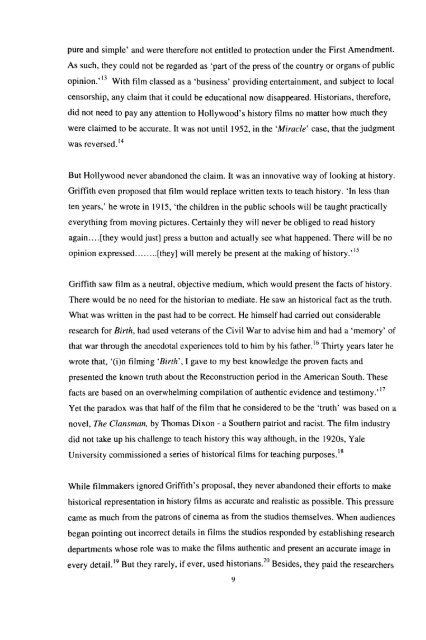Download (3483kB) - Greenwich Academic Literature Archive ...
Download (3483kB) - Greenwich Academic Literature Archive ...
Download (3483kB) - Greenwich Academic Literature Archive ...
- No tags were found...
Create successful ePaper yourself
Turn your PDF publications into a flip-book with our unique Google optimized e-Paper software.
pure and simple' and were therefore not entitled to protection under the First Amendment.As such, they could not be regarded as 'part of the press of the country or organs of publicopinion.' 1 With film classed as a 'business' providing entertainment, and subject to localcensorship, any claim that it could be educational now disappeared. Historians, therefore,did not need to pay any attention to Hollywood's history films no matter how much theywere claimed to be accurate. It was not until 1952, in the "Miracle" case, that the judgmentwas reversed. 14But Hollywood never abandoned the claim. It was an innovative way of looking at history.Griffith even proposed that film would replace written texts to teach history. 'In less thanten years,' he wrote in 1915, 'the children in the public schools will be taught practicallyeverything from moving pictures. Certainly they will never be obliged to read historyagain.... [they would just] press a button and actually see what happened. There will be noopinion expressed........[they] will merely be present at the making of history.' 15Griffith saw film as a neutral, objective medium, which would present the facts of history.There would be no need for the historian to mediate. He saw an historical fact as the truth.What was written in the past had to be correct. He himself had carried out considerableresearch for Birth, had used veterans of the Civil War to advise him and had a 'memory' ofthat war through the anecdotal experiences told to him by his father. 16 Thirty years later hewrote that, '(i)n filming "Birth1 , 1 gave to my best knowledge the proven facts andpresented the known truth about the Reconstruction period in the American South. Thesefacts are based on an overwhelming compilation of authentic evidence and testimony.' 17Yet the paradox was that half of the film that he considered to be the 'truth' was based on anovel, The Clansman, by Thomas Dixon - a Southern patriot and racist. The film industrydid not take up his challenge to teach history this way although, in the 1920s, YaleUniversity commissioned a series of historical films for teaching purposes. 18While filmmakers ignored Griffith's proposal, they never abandoned their efforts to makehistorical representation in history films as accurate and realistic as possible. This pressurecame as much from the patrons of cinema as from the studios themselves. When audiencesbegan pointing out incorrect details in films the studios responded by establishing researchdepartments whose role was to make the films authentic and present an accurate image inevery detail. 19 But they rarely, if ever, used historians. 20 Besides, they paid the researchers9
















